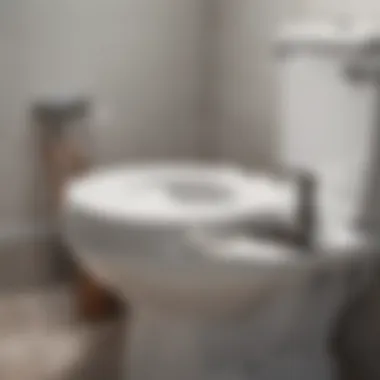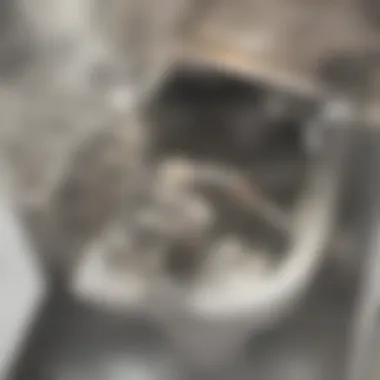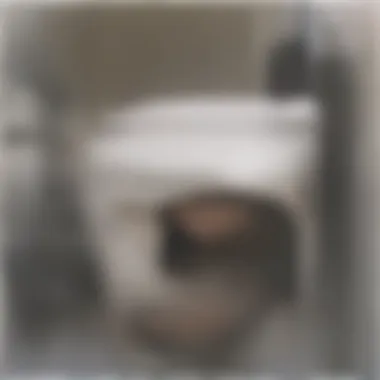Effective Strategies for Snaking Your Toilet


Intro
Dealing with a clogged toilet can be a daunting task for anyone. Understanding how to navigate this issue is essential for homeowners and maintenance personnel alike. This guide will delve into the process of snaking your toilet, a crucial method for restoring proper function when faced with blockages. As you read on, you will discover necessary tools, step-by-step instructions, and useful tips on preventing future clogs.
Equipping yourself with knowledge about your plumbing system can save you time and help you avoid costly professional help. This article will walk through each step, ensuring clarity and confidence in tackling this common household problem.
Prelims to Toilet Clogs
Understanding toilet clogs is crucial for homeowners and any individual who regularly interacts with plumbing systems. Having a basic knowledge of the causes and implications of clogs can empower you to take swift and effective action. This section is not merely an introduction; it lays the foundation for comprehending the necessity of the snaking process. Without awareness of how clogs form, it can be challenging to appreciate why and when a snake should be used.
Toilet clogs are problematic because they disrupt a household's normal flow of operations. They can lead to more serious plumbing issues if they are not addressed promptly. Recognizing the signs of a clog early can also save time and potentially costly repairs. The following subsections will examine the nature of clogs and common causes, offering insights into how to mitigate them effectively.
Understanding Toilet Clogs
Toilet clogs occur when solid waste or foreign objects obstruct the flow of water through the plumbing system. A number of factors contribute to how quickly and easily a toilet may clog. Clogs can be mild, requiring only a plunger, or severe, necessitating advanced methods such as snaking. Understanding these dynamics helps in diagnosing problems faster. Identifying the underlying cause of a clog can also assist in determining the best course of action.
Common Causes of Clogs
Clogs can be attributed to several everyday issues. It's key to identify these causes to prevent future occurrences. Common causes include:
- Excessive toilet paper: Using too much toilet paper can overwhelm the flushing mechanism, leading to blockages.
- Foreign objects: Items such as toys, sanitary products, and wipes can easily fall into the toilet, creating clogs.
- Hard water deposits: Mineral buildup in pipes can narrow the passage, making it easier for waste to get stuck.
- Septic system issues: In older homes, a failing septic system can manifest as recurring toilet clogs.
What is Snaking?
Snaking is a vital process in the realm of plumbing, specifically when dealing with toilet blockages. Understanding what snaking entails can help homeowners effectively maintain their plumbing systems. This section clarifies the definition of snaking and discusses when one should resort to this method.
Defining Snaking
Snaking a toilet refers to the technique of using a plumbing snake, also known as an auger, to remove clogs in the toilet’s drain. These clogs can arise from various materials, including toilet paper, foreign objects, or excessive waste. The tool itself consists of a flexible, coiled metal wire designed to navigate the twists and turns of a toilet's plumbing.
The importance of snaking lies in its ability to clear obstructions without needing to disassemble the toilet, thus saving both time and effort. By inserting the snake into the toilet and maneuvering it through the drain, homeowners can break up or remove the clog safely and effectively.
When to Snake a Toilet
There are several situations when you should consider snaking your toilet. Recognizing these indicators can save you from further plumbing issues. Here are some key signs:
- Frequent Clogs: If clogs happen repeatedly, it may be a sign of deeper plumbing issues. Regular snaking can prevent more severe problems.
- Slow Draining: When the toilet is draining slowly, it indicates that there may be a partial blockage. Snaking at this stage can restore normal flow.
- Multiple Fixtures Affected: If a toilet clog is accompanied by slow drains in other fixtures, it’s likely a sign of a more significant issue in the plumbing system that needs addressing.
- Strange Noises: Unusual noises when flushing can indicate air trapped in the plumbing due to a blockage. Snaking may resolve this.
- Visual Inspection: If you have previously removed an object from the toilet or noticed a significant buildup, it is advisable to snake to ensure there is no lingering obstruction.
Snaking is often the best first step in tackling a clogged toilet before resorting to more invasive plumbing repairs.
It’s essential to be mindful of these signs and take action promptly. Regular maintenance through snaking can help maintain a properly functioning plumbing system, thereby avoiding emergencies.
Tools Required for Snaking
Understanding the tools required for snaking a toilet is essential for a successful plumbing task. Using the right equipment makes the job easier and more effective. When dealing with a clogged toilet, having the appropriate tools can save time and reduce the risk of damaging your plumbing system. This section covers the various types of snakes, as well as additional tools that can aid in the snaking process. Each tool plays a significant role in ensuring that you can tackle a clog efficiently and safely.
Types of Snakes
There are several types of snakes designed specifically for toilet use. The most common types include:
- Toilet Auger: A toilet auger is often seen as the best option for unclogging toilets. It is designed with a long, flexible shaft and a corkscrew end that allows it to navigate through curved pipes. It's effective at reaching deep clogs without damaging the porcelain finish of the toilet.
- Plumber’s Snake: This type of snake is longer and can be used for drains and pipes beyond just the toilet. It is usually more robust and capable of removing heavy blockages. However, it may not always be suitable for the tight bends found in toilet traps.


Each of these snakes has its advantages and disadvantages. Toilet augers are typically easier to handle for novice users, while plumber’s snakes provide versatility for various plumbing issues.
Additional Tools
In addition to snakes, some extra tools can enhance your toilet snaking efforts. These tools can make the entire process cleaner and more efficient.
Gloves
Using gloves is critically important when snaking a toilet. They provide a necessary barrier between your hands and any potential contaminants. The key characteristic of good gloves is their waterproof quality, allowing you to handle wet areas without immediate skin contact.
Investing in thick, disposable gloves can be beneficial. They ensure a proper grip when dealing with the slippery surfaces of the toilet and the snake. However, it is important to use gloves made of materials that resist tearing, as you want to avoid any accidental exposure to waste.
Plunger
A plunger is another tool that often accompanies snaking efforts. Its primary use is to dislodge more superficial clogs. The effectiveness of plungers comes from their design, which creates suction and pressure to push through blockages. An important aspect of a good plunger is the rubber cup, which should be wide enough to fit snugly over the toilet drain.
Plungers are an ideal preliminary step before employing a snake. It can help loosen some clogs, making the snaking process easier. However, they are not always effective for deeper, more severe clogs in the plumbing system.
Towels
Finally, towels are fundamental when snaking a toilet. They are useful for cleaning up any spills or messes that occur during the process. When snaking, you may encounter some water and debris. Having towels on hand allows for quick clean-up and helps maintain a hygienic environment.
The key characteristic of towels is their absorbency. Using thicker towels is often recommended, but they should also be strong enough to withstand wet conditions without falling apart. While using towels does not directly assist in the snaking process, their presence ensures that you can manage cleanliness effectively.
Having the right tools on hand is fundamental to tackling any clog effectively, safeguarding both your plumbing system and your home’s cleanliness.
Step-by-Step Snaking Process
The step-by-step snaking process is crucial for anyone facing the frustrating reality of toilet clogs. Effectively navigating this process involves understanding the stages of snaking and executing them with precision. Each step serves a specific purpose, ensuring clogs are efficiently removed while minimizing potential damage to your plumbing. Moreover, grasping this procedure empowers homeowners and maintenance technicians alike, transforming a daunting task into a manageable undertaking. This structured approach enhances both confidence and competence during the process.
Preparation
Preparation is a pivotal first step when snaking your toilet. Proper preparation can greatly influence the success of the task and ensure safety. Before initiating the snaking, gather all necessary tools: a toilet auger, gloves, a plunger, and towels. Make sure you wear gloves to protect your hands from bacteria and any mess. Clearing the area around the toilet enhances maneuverability and reduces the risk of accidents. Additionally, placing towels on the floor can help absorb spills.
It's also wise to inform any household members about the operation. This can prevent unnecessary disruptions, allowing for a focused and efficient snaking experience.
Inserting the Snake
Inserting the snake requires careful technique to ensure it reaches the clog without causing damage to the toilet. Start by inserting the end of the toilet auger into the bowl, aiming to push it past the trapway as much as possible. Maintain a steady grip on the handle of the snake while gradually turning it clockwise. This rotation helps the auger navigate the intricate bends in the toilet's plumbing. Avoid excessive force; too much pressure can lead to cracks in the porcelain or create more significant plumbing issues.
Navigating the Trap Bend
The trap bend in a toilet presents a unique challenge when snaking. The trap bend is a curved section of the plumbing designed to retain water and prevent sewer gases from entering the home. It is essential to guide the snake through this bend carefully. As you continue pushing and turning the auger, you may feel resistance. It is often a sign that you have reached the clog. Keep exercising caution; forcing the snake could break the toilet or dislodge pipe fittings.
Retrieving the Snake
Retrieving the snake correctly is as important as inserting it. Once you feel that the clogs have been cleared, gently pull back the snake while continuing to turn it counter-clockwise. This action allows any debris or waste clinging to the end of the auger to detach and fall into the toilet bowl. Inspect the snake for any stuck material before fully withdrawing it. After removal, flush the toilet to ensure everything is functioning correctly. It's advisable to clean the snake thoroughly before storing it away to prevent contamination or odors.
The step-by-step process highlights the importance of each stage while instilling confidence in managing toilet clogs. Following these guidelines will help you navigate the intricacies of snaking your toilet successfully.
Safety Considerations


Navigating the task of snaking a toilet involves not only understanding the technical aspects but also prioritizing safety. The process can expose you to various hazards, especially if the appropriate precautions are not taken. Ensuring a safe environment protects both the individual performing the task and the integrity of the plumbing system.
Proper safety measures reduce the risk of injury and contamination; therefore, it is essential to approach this process with respect for the materials and tools involved.
Protective Gear
The first step in ensuring safety during snaking is wearing the right protective gear. This equipment serves to shield you from potential splashes and unwanted contact with bacteria-laden waste. Recommended items include:
- Rubber Gloves: These provide a barrier against harmful microorganisms that can cause illness.
- Safety Glasses: Protect your eyes from any debris that may escape during the snaking process.
- Work Boots: Sturdy footwear keeps your feet safe from accidentally dropping tools or other materials.
By armoring yourself with necessary gear, you minimize the likelihood of any adverse health effects. Neglecting to wear protective gear can lead to infections or exposure to hazardous elements.
Handling Waste Safely
Handling waste safely is paramount when performing any plumbing task, particularly during snaking. A clogged toilet often contains biological material, which can pose serious health risks. Here are some practical considerations:
- Disinfect Tools and Surfaces: Always clean your tools and your workspace after the job is done to eliminate any traces of contaminants.
- Use Disinfectant: Before and after completing the task, apply a disinfectant to all tools and surfaces that might have come into contact with waste.
- Avoid Direct Contact: If you need to remove any solid waste, use a tool rather than your hands to avoid direct exposure.
“Failing to handle waste properly can lead to serious health complications; safeguard your hygiene as a priority.”
By being careful with waste during the snaking process, one could prevent contamination and maintain a safer environment. This approach not only benefits the individual conducting the task but also the household overall.
Troubleshooting Common Issues
In any plumbing endeavor, understanding how to troubleshoot common issues is crucial. In the context of snaking a toilet, identifying problems early ensures effective action. It prevents further complications, saving both time and resources. Homeowners often face confusion when confronting persistent clogs or equipment failures. Addressing these topics will equip them with the necessary skills to manage their plumbing systems more effectively.
Unresponsive Clogs
An unresponsive clog is a prevalent issue encountered during the snaking process. This situation arises when the snake fails to dislodge the obstruction. Several factors contribute to this problem. First, the clog might be too substantial or situated deeper within the plumbing system than anticipated. Second, the type of snake used may not be appropriate for the specific blockage, such as using a kitchen snake for a toilet.
When faced with an unresponsive clog, one should consider the following steps:
- Re-evaluate Equipment: Ensure that the right type of snake is used. A toilet auger is typically more effective than a standard plumbing snake.
- Increase Torque: Applying gentle pressure can sometimes provide the force needed to break free the clog. However, avoid excessive force, as this might damage the toilet.
- Alternate Techniques: If snaking does not yield results, consider employing a plunger or a commercial drain cleaner as additional methods.
Remember that patience is key with these issues. If the clog remains unresponsive after multiple attempts, it might be wise to consult a plumbing professional.
Broken or Damaged Snake
Using a damaged or broken snake can lead to ineffective plumbing solutions, and it may even exacerbate the existing issues. Damage can occur due to frequent use or improper handling. Signs of a broken snake include missing coils, bends in the shaft, or an inability to extend fully. If any of these issues exist, using such a tool can worsen the clog or create new blockages.
Here are approaches to prevent and deal with this issue:
- Inspect Regularly: Before starting any snaking task, inspect the snake for signs of wear. Look for broken or bent sections that could hinder performance.
- Use Proper Techniques: Handle the snake carefully to prevent bends and breaks during operation. Follow manufacturer instructions carefully regarding techniques and usage.
- Invest in Quality: Selecting high-quality snakes, such as those from RIDGID or General Wire Spring, can lower the risk of premature damage.
In case of a broken snake during use, cease operation immediately to prevent injuries or further clogging. Always keep a backup snake to ensure continuity of work.
Regular maintenance of your tools will help avoid common troubles associated with snaking, ensuring efficient plumbing performance.
Preventative Maintenance for Toilets
Preventative maintenance for toilets plays a crucial role in ensuring that plumbing systems function smoothly over time. By regularly performing maintenance tasks, homeowners can significantly reduce the likelihood of clogs and other plumbing issues. This proactive approach not only saves time and effort but also reduces costly repairs in the long run.


One of the primary benefits of preventative maintenance is that it allows for the early detection of potential problems. By routinely inspecting the toilet and associated plumbing, individuals can identify issues such as slow drainage or unusual noises before they escalate into severe blockages or leaks. This can prevent unexpected situations that disrupt daily life._
In addition, preventative measures foster a better understanding of how to effectively use and care for a toilet. Simple actions, like being mindful of what goes into the toilet, can minimize risks. For example, flushing items like wipes or excessive toilet paper can quickly lead to clogs. Being aware of these factors encourages better habits, reinforcing the importance of maintenance.
Regular Inspections
Regular inspections are an essential aspect of maintaining a toilet. Homeowners should schedule these checks every few months, examining both the toilet unit and the plumbing leading to it. Looking for any signs of wear or leaks can help maintain optimal function. Check conditions like:
- Water stains around the base
- Weak flushing performance
- Unusual noises when flushing
Inspections can often catch minor issues before they develop into significant problems. For instance, a small leak may be an indication of a larger issue within the plumbing system. Similarly, inspecting the toilet's components, like the flapper and fill valve, can help ensure everything is functioning correctly.
Best Practices for Toilet Use
Implementing best practices for toilet use is fundamental in preventing problems. Educating all household members about what items are appropriate for flushing is essential. Some useful guidelines include:
- Only flush toilet paper.
- Dispose of sanitary products, wipes, and oils properly in the trash.
- Be mindful of how much paper is used during each use.
Moreover, users should avoid using the toilet as a trash bin. Items such as dental floss, cotton swabs, and other small materials should never go down the toilet. The consequences of disregarding these practices can result in costly plumbing interventions.
In summary, preventative maintenance fosters a well-functioning toilet system. Regular inspections and adherence to best practices can lead to a smoother plumbing experience, minimizing distress and unexpected repairs. By prioritizing these efforts, homeowners can preserve their plumbing systems' integrity over time.
When to Call a Professional
Dealing with frequently clogged or slow-flushing toilets can be a frustrating experience. While many issues can be fixed using basic snaking techniques, some situations demand professional intervention. Understanding when to call a plumber is essential for preventing further damage to your plumbing system and ensuring a quick resolution to your problems.
Signs of Severe Issues
Recognizing the signs that indicate severe issues is critical. Here are some warning signals:
- Multiple Clogs: If more than one toilet or drain in your home is experiencing clogs, it could signify a larger problem in your sewer line.
- Persistent Backups: Regular backups despite repeated snaking efforts suggest that the obstruction is beyond your reach and requires specialized tools and expertise.
- Foul Odors: Bad smells emanating from your toilet may indicate sewage issues, which require urgent professional help to address safely.
- Water Damage: Visible signs of water damage, such as stains on walls or ceilings, can mean that there is a leak in your plumbing system, necessitating immediate attention.
If you notice any of these signs, it is prudent to call a plumber rather than risk worsening the issue through DIY methods.
Emergency Situations
Not all plumbing problems can wait. Here are circumstances classified as emergencies:
- Overflowing Toilets: If your toilet is overflowing and cannot be stopped, this poses both a sanitation issue and potential damage to your home.
- Severe Blockages: When you suspect that a blockage is causing flooding, calling a professional quickly can prevent significant damage to your home.
- Sewage Backup: If raw sewage backs up into your toilet or drains, this is hazardous to your health and must be addressed immediately by a qualified professional.
Recognizing these key indicators will help determine when it’s necessary to bring in a professional. Acting promptly can save time, money, and potential damage to your property.
Ending
In this article, we emphasized the significance of effectively snaking your toilet to maintain a functional plumbing system. Addressing clogs promptly avoids further complications that can escalate into more severe plumbing issues. This simple task not only saves time and money but also promotes hygiene and convenience in your home.
Summary of Best Practices
Using the correct approach is vital. Here are some best practices to keep in mind:
- Always wear protective gear. Safety is important, especially since you are dealing with waste.
- Use the right tools. Ensure that your snake is appropriate for your toilet to avoid causing damage.
- Follow the steps carefully. Inserting and navigating the snake requires focus. Improper handling can worsen the clog.
- Maintain regular inspections. Preventative maintenance is key. Checking for signs of slow drainage can help you act before an issue escalates.
An ounce of prevention is worth a pound of cure.
Final Thoughts
Overall, understanding the process of snaking your toilet is beneficial for homeowners. This knowledge enables you to tackle minor plumbing issues independently. By being prepared and knowing when to seek professional help, you can confidently manage your home’s plumbing. Always remember that while snaking is a useful skill, some situations require expert assistance to mitigate long-term issues. In the realm of home maintenance, being informed enhances your ability to protect your investment.







